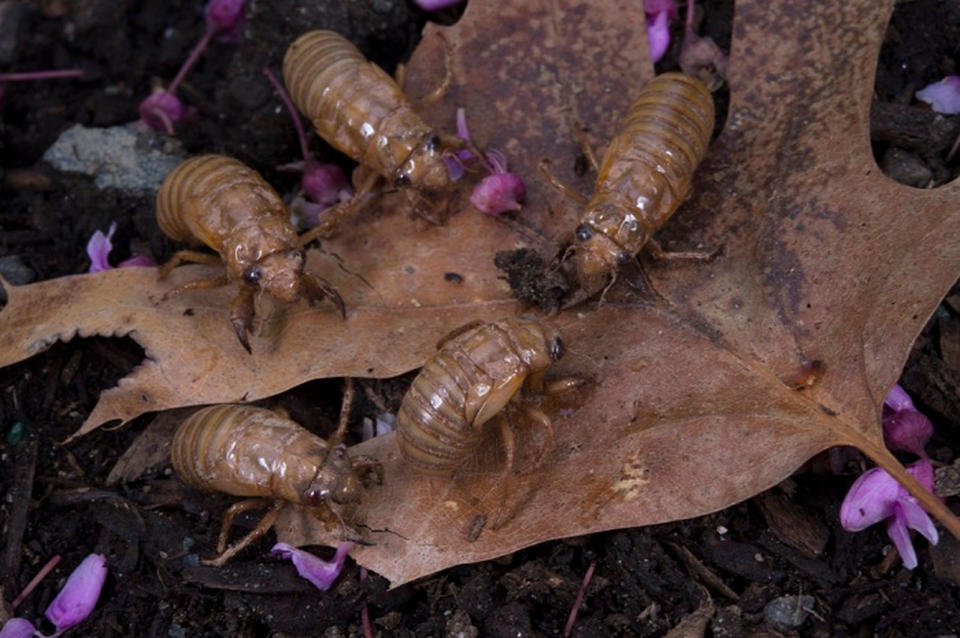Facts About Cicadas
Cicadas are oval-shaped, winged insects that provide a buzzing and clicking song heard in nature throughout the summer. Most cicadas appear every year in late June through August, while others emerge only every few years.
Size and appearance
There are around 3,000 cicada species, according to National Geographic, so they vary in size from 0.75 to 2.25 in (2.2 to 5.5 cm) long. Cicadas can be black, brown or green and can have red, white or blue eyes.
Their wings are transparent and can seem rainbow-hued when held up to a light source. The veins on the tips of the wings of some cicadas make the shape of a W.
Habits
Cicadas are found only in the eastern half of the United States. They live a relatively long time — 4 to 17 years, depending on whether they are annual or periodical cicadas. The periodical cicadas live the longest.
They spend most of their lives underground as larvae, followed by a short adulthood — from two to six weeks — above ground, according to the University of Michigan's Museum of Zoology.
There are generally two types of cicadas. Annual cicadas emerge every year in late June or August, while periodical cicadas emerge in cycles of 13 or 17 years, depending on the species. When periodical cicadas emerge, all the adults in a given location emerge at the same. Tens of thousands to over a million insects can reside in a relatively small area of land. A group of periodicals that emerge at the same time is called a brood. Broods are classified with Roman numerals that represent each group. There are 30 broods in all. [Your Guide to the 2017 Cicada Season]
Diet
Though a group of these insects are called a cloud or plague, cicadas usually don't cause the harm that locusts cause to crops and local vegetation.
Cicadas are herbivores. This means they eat vegetation. Young cicadas eat liquid from plant roots, while molting cicadas eat twigs. Adult cicadas do not feed, according to U.S. Department of Agriculture.

Offspring
The buzzing sound they make is a mating call. Male cicadas vibrate a white, drumlike membrane on their abdomens called a tymbal. A group of singing cicadas is called a chorus. The singing attracts both males and females to a certain area. The males join in on the singing and the females mate with the males.
Cicadas start their lives as eggs above ground. When they hatch, they burrow down into the ground. For food, they suck liquid out of plant roots, since their mothers do not care for them. The babies, known as nymphs, molt in five growth cycles. These growth cycles are called instars.
It is thought that cicadas know when to all emerge at once due to ground temperature. When the ground temperature at a depth of 8 inches (20 centimeters) reaches 64 degrees Fahrenheit (18 degrees Celsius) the nymphs know it is time to come out, according to the National Oceanic and Atmospheric Administration. Some think that other factors, such as changes in tree's root fluid, may also signal nymphs to emerge.
Once top-side, the nymphs grow wings and appear white. As their exoskeleton hardens they become darker. The hardening can take four to six days, according to the University of Michigan. Once they are fully hardened, they are mature and ready to mate. The females lay around 20 eggs at a time in slits they cut in tree branches. The eggs hatch within six to 10 weeks.
Classification/Taxonomy
Here is the taxonomy of cicadas, according to the Integrated Taxonomic Information System:
Kingdom: Animalia
Subkingdom: Bilateria
Infrakingdom: Protostomia
Superphylum: Ecdysozoa
Phylum: Arthropoda
Subphylum: Hexapoda
Class: Insecta
Subclass: Pterygota
Infraclass: Neoptera
Superorder: Paraneoptera
Order: Hemiptera
Suborder: Auchenorrhyncha
Infraorder: Cicadomorpha
Superfamily: Cicadoidea
Family: Cicadidae
The most prominent and best-studied cicadas are six periodical species belonging to the genus Magicicada, according to the University of Michigan. Three species have 13-year cycles, and three have 17-year cycles.
Conservation status
While no species of cicada are endangered, a few are at risk, according to the International Union for Conservation of Nature (IUCN). The union's Red List of Threatened Species lists the Cassini periodical cicada, the Decim periodical cicada and the Decula periodical cicada as lower risk/near threatened, although no reasons for those assessment are given.
Other facts
Some cicada calls can be heard up to 1 mile (1.5 kilometer) away, according to National Geographic.
Cicadas do not sting or bite, according to the University of Michigan.
When they leave their burrow, sometimes cicadas will make chimneys of mud over the exit.
Each species of cicada has a different song.
Additional resources



